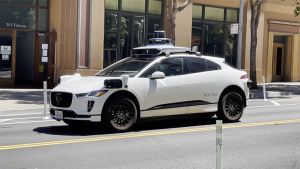Tech Startup Spotlight: Waymo
Mark DiPietro
Technology Editor
With the recent uptick in popularity for Artificial Intelligence, people are constantly asking how this new tool can be used to improve people’s lives. One avenue that has been discussed for years is self-driving cars. Almost everyone has heard of this mission for autonomous driving, but few realize just how developed far down the path we currently are. To some readers, it may come as a surprise that autonomous trips are being done at full capacity on public roads in some parts of the country every day. This article will take a deep dive on one of the leading tech companies in this sphere that is making this pipe dream a reality, Waymo.
Waymo, whose name is a play off the phrase “a new way forward in mobility”, began as a project within Google in 2009. The project was initially called the Google Self-Driving Car Project. It was led by Sebastian Thrun, a former Stanford professor and founder of Google X, the company’s innovation lab. The original scope of the project was to develop cars that were able to drive uninterrupted, 100-mile routes completely on their own.

The first leap forward was with a vehicle called the “Firefly”. A custom-built car that had no steering wheel or pedals and a pre-planned, specified route. Regardless of the obvious limitations of these vehicles, in 2015 Steve Mahan, a legally blind man, became the passenger to the world’s first fully automated ride on public roads in Austin, Texas.
In 2016, with the creation of Alphabet Inc., Waymo was officially born. With the new consolidated company, which was originally formed in 2015, Waymo now serves as a holding company for Google and its various subsidiaries. After the reorganization, the company used this freedom and an explosion in AI and machine learning technology to rethink the practical future of developing and testing self-driving technology with the goal of making autonomous vehicles safe and accessible for everyone. Instead of making specially built vehicles that were expensive and limited, the team tried retrofitting conventional cars with an augmented reality style sensor system to detect obstacles and improve navigation. In no time, the new Waymo began testing them on public roads.
After extensive tests and trial periods in the suburb of Chandler and the Metro Phoenix areas, Waymo One, the world’s first commercial autonomous ride-hailing service, was launched in 2020 to the general public in a 50 square mile service area in the heart of downtown Phoenix. Then, the service provided access to Chrysler Pacifica mini vans. Today, the service offers Jaguar I-Paces, fully electric SUVs. In 2021, the service was expanded to San Francisco and Los Angeles at a trial capacity.

As far as conditions, Arizona was an ideal place to begin the self-driving experiment. It is dry, flat, and well spread out geographically, providing ample room for pulling over and avoiding obstacles. Arizona’s climate makes it especially advantageous when considering electric vehicles, and the number of miles they can traverse, struggle mightily in cold weather.
But the biggest challenges that Waymo will face is scalability. Not every city has ideal climate and some of the things that make cities good for pilot sites conversely hurt Waymo as a business. Cities with wider geographic reach have more residents with cars, thus decreasing demand for ride sharing. Additionally, a huge factor that impacts ride sharing is reasonable wait times, which can only be achieved with a substantial amount of operational vehicles per square foot. At estimates of $100 thousand per vehicle at this point, Waymo may stay very regional until the technology becomes cheaper.
Waymo’s ultimate probability for success aside, it is clear that they are a leader in the Automated Vehicle industry. They have successfully deployed rider-only car services in a major metropolitan environment with limited issues thus far, a feat that most would have viewed as impossible 10 years ago. Market watchers should keep an eye on Waymo, as well as this sector of the Tech industry, very closely as it continues to make leaps and bounds if they have any intention of staying ahead of competition.
Contact Mark at markdipietro04@gmail.com

